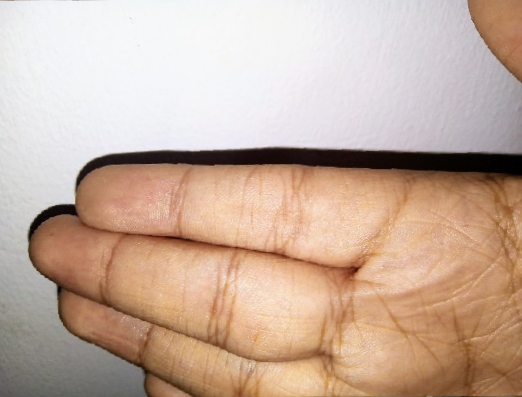Skin Fold on:
[Wikipedia]
[Google]
[Amazon]
Skin folds or skinfolds are areas of 
skin
Skin is the layer of usually soft, flexible outer tissue covering the body of a vertebrate animal, with three main functions: protection, regulation, and sensation.
Other animal coverings, such as the arthropod exoskeleton, have different ...
that are naturally folded. Many skin folds are distinct, heritable anatomical features, and may be used for identification of animal species
A species () is often defined as the largest group of organisms in which any two individuals of the appropriate sexes or mating types can produce fertile offspring, typically by sexual reproduction. It is the basic unit of Taxonomy (biology), ...
, while others are non-specific and may be produced either by individual development of an organism or by arbitrary application of force to skin, either by the actions of the muscle
Muscle is a soft tissue, one of the four basic types of animal tissue. There are three types of muscle tissue in vertebrates: skeletal muscle, cardiac muscle, and smooth muscle. Muscle tissue gives skeletal muscles the ability to muscle contra ...
s of the body or by external force, e.g., gravity
In physics, gravity (), also known as gravitation or a gravitational interaction, is a fundamental interaction, a mutual attraction between all massive particles. On Earth, gravity takes a slightly different meaning: the observed force b ...
. Anatomical folds can also be found in other structures and tissues besides the skin, such as the ileocecal fold beneath the terminal ileum of the cecum.
Skin folds are of interest for cosmetology
Cosmetology (from Greek , ''kosmētikos'', "beautifying"; and , ''-logia'') is the study and application of beauty treatment. Branches of specialty include hairstyling, skin care, cosmetics, manicures/ pedicures, non-permanent hair removal suc ...
, as some kinds may be considered aesthetically undesirable, and for medicine
Medicine is the science and Praxis (process), practice of caring for patients, managing the Medical diagnosis, diagnosis, prognosis, Preventive medicine, prevention, therapy, treatment, Palliative care, palliation of their injury or disease, ...
, because some of them are susceptible to inflammation
Inflammation (from ) is part of the biological response of body tissues to harmful stimuli, such as pathogens, damaged cells, or irritants. The five cardinal signs are heat, pain, redness, swelling, and loss of function (Latin ''calor'', '' ...
and infection
An infection is the invasion of tissue (biology), tissues by pathogens, their multiplication, and the reaction of host (biology), host tissues to the infectious agent and the toxins they produce. An infectious disease, also known as a transmis ...
.

Skin creases, skin folds and lines
The skin creases of the human body are features of great anatomical, morphological, and surgical interest and important for the maintenance of the contour of each anatomic area. In the literature, when referring to a skin crease, there is variation of terms used other than "crease", such as "fold" and " sulcus", but these terms do not accurately reflect their histology structure nor their function. In the review of literature, a record of the creases of the human body for each anatomic area, including the synonyms that are used for each crease in the literature, has been attempted. The skin crease as a fixed and permanent line, according to theirhistology
Histology,
also known as microscopic anatomy or microanatomy, is the branch of biology that studies the microscopic anatomy of biological tissue (biology), tissues. Histology is the microscopic counterpart to gross anatomy, which looks at large ...
, is related to connective tissue attachments with the underlying structures or extensions of the underlying muscle fibers
Skeletal muscle (commonly referred to as muscle) is one of the three types of vertebrate muscle tissue, the others being cardiac muscle and smooth muscle. They are part of the somatic nervous system, voluntary muscular system and typically are a ...
in the dermis
The dermis or corium is a layer of skin between the epidermis (skin), epidermis (with which it makes up the cutis (anatomy), cutis) and subcutaneous tissues, that primarily consists of dense irregular connective tissue and cushions the body from s ...
of the crease site.
The skin fold is characterized by skin redundancy that is responsible partly, often in combination with connective tissue attachments, for the skin crease. It is essential to use appropriate terms that accurately reflect the anatomic structure and histology when referring to the skin lines.
Human skin folds
The following distinct skin fold types are among the roughly 100'' Dorland's Illustrated Medical Dictionary'', 27th edition, pp. 645–6 identified inhuman anatomy
Human anatomy (gr. ἀνατομία, "dissection", from ἀνά, "up", and τέμνειν, "cut") is primarily the scientific study of the morphology of the human body. Anatomy is subdivided into gross anatomy and microscopic anatomy. Gross ...
:
* Nasolabial fold
* Epicanthal fold
* Interdigital folds (Plica Interdigitalis)
* Inframammary fold
* Triceps skinfold
* Webbed neck
See also
*Wrinkle
A wrinkle, also known as a rhytid, is a fold, ridge or crease in an otherwise smooth surface, such as on skin or fabric. Skin wrinkles typically appear as a result of ageing processes such as glycation, habitual sleeping positions, loss of b ...
* Skin line
* Pannus
* Dimple
*Intertrigo
Intertrigo, commonly called “skin fold dermatitis”, refers to a type of inflammatory rash (dermatitis) of the superficial skin that occurs within a person's body folds. These areas are more susceptible to irritation and subsequent infection d ...
*Irritant diaper dermatitis
Irritant diaper dermatitis (IDD, also called a diaper rash or nappy rash) is skin rash in the diaper (in British and Australian English "nappy") area, caused by various skin disorders and/or irritants.
Generic irritant diaper dermatitis is charac ...
* Inverse psoriasis
References
{{Reflist fold Human anatomy